December 2011
Monthly Archive
Wed 7 Dec 2011
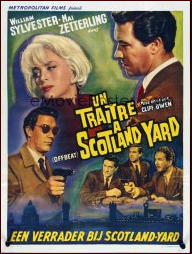
OFFBEAT. British Lion Film Corp., 1963. Also released as The Devil Inside. William Sylvester, Mai Zetterling, John Meillon, Anthony Dawson, Neil McCarthy, Harry Baird, John Phillips. Director: Cliff Owen.
When Scotland Yard finds themselves up against a brick wall in tracking down a vicious gang of thieves and bank robbers, they call in Layton, a loner from MI5 (William Silvester) to work his way into the gang and help bring them down.
Taking the new name of Steve Ross, Layton finds the gang organized like a business, a well-oiled machine, with salaries, fringe benefits, and best of all, a comradery that Layton has never known before. Well, perhaps, not quite best of all. One of the of the members of his new group of friends is Ruth Lombard (Mai Zetterling), with whom he finds an instant (and mutual) attraction.
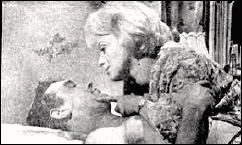
Much of the middle of the film is a caper drama, as the men drill their way into a underground vault filled with jewels – in plain sight, yet. If you thought being a crook meant not having to do manual labor, you would be wrong.
Does Layton renege on his day job for the Yard, or can he find himself able to turn the gang in when the robbery is done? That’s the question, the key one, and after a slow beginning, I’d have to say that halfway into the film if not earlier, I was hooked to the screen, waiting for the answer. A minor film, to be sure, but recommended, definitely so.
Wed 7 Dec 2011
Posted by Steve under
Reviews[3] Comments
REVIEWED BY RAY O’LEARY:

K. K. BECK – The Body in the Volvo. Walker, hardcover, 1987. Hardcover reprint: Detective Book Club, 3-in-1 edition. Ivy Books, paperback reprint, 1989.
— Peril Under the Palms. Walker, hardcover, 1989. Ivy Books, paperback reprint, 1990.
Two novels, Body set in contemporary times, while Perils is the third of Beck’s period novels set in the ’20s, featuring “flapper” detective Iris Cooper and her erstwhile boyfriend, newshound Jack Clancey.
The Body in the Volvo — which may be the first “academic” whodunit set in an Auto Repair Shop — centers on Charles Garstairs, a young professor at the University of Washington who has just been denied Tenure by a committee headed by Dr. Bateman, who thought Carstairs was fooling around with his wife.

Charles’ uncle Cosmo wins the State Lottery and signs his Auto Repair Shop over to Charles, a very mixed blessing since the Shop’s assets turn out to include an old Volvo — which turns out to contain the body of Dr. Bateman, whose wife reported him missing several days earlier.
Naturally, this puts Charles rather high on the Suspect Scale, and, with the help of bookkeeper Sylvia Snow, he must find the real killer.
In Perils Under the Palms, Iris and her Aunt are vacationing with friends in Hawaii when one of the friends starts seeing a ghostly apparition and another turns up murdered. Jack Clancey arrives on one of the first air flights to the Islands and the Game’s afoot.
Both of these are lightweight, enjoyable and entertaining enough, but I get the feeling that if I read them again in a few years, I’ll have forgotten all about them.
— Reprinted from
A Shropshire Sleuth #52, March 1992.
Tue 6 Dec 2011
DVD: THE BEST OF B.L. STRYKER (Two “Classic Episodes”)
Reviewed by Michael Shonk
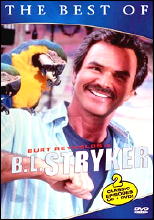
B.L. STRYKER. Universal. Part of the rotating series in ABC Mystery Movie (with Columbo, Kojak, Gideon Oliver, Christine Cromwell) February 1989 through August 1990. Two seasons; 12 episodes, two hours each. CAST: Burt Reynolds as B.L. (Buddy Lee) Stryker, Ossie Davis as Oz Jackson, Rita Moreno as Kimberly, Michael O. Smith as Chief McGee. Created by Christopher Crowe. Executive Producer: Tom Selleck. Co-Executive Producer: Burt Reynolds. Supervising Executive Producer: William Link. Producer: Alan Barnette. Story Editor: Joe Gores.
“The Dancer’s Touch” (February 13, 1989) Guest Cast: Helen Shaver as Diane. Teleplay by Leon Piedmont and Walter Klenhard and Chriss Abbott. Story by Leon Piedmont. Directed by William Fraker.
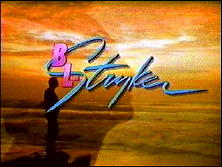
As a New Orleans cop, Stryker could get into the mind of the bad guy until he would know the bad guy’s next move before he did. After too many bad guys in his head, Stryker snapped and beat a rapist nearly to death. Now he tries to make it through the day living on a broken down houseboat on the “wrong side of the river” of his hometown, Palm Beach. Helping him is his best friend, a washed up boxer, Oz Jackson.
But Stryker’s past has caught up with him as a rapist, using the exact same methods as the one from New Orleans, is attacking rich young girls on the “right side of the river” of Palm Beach.
The chemistry between Reynolds and Davis and the relationship between their characters is special and their scenes together are the best this show has to offer. Sadly, it is not enough to overcome the weak mystery, bad melodrama, predictable twists, and a sea of cliches.
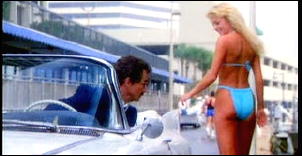
The supporting cast features such overused types as the frustrated Police Chief who looks the other way while Stryker gets things done, the rich annoying ex-wife, the ex-wife’s maid who speaks her mind, and the comedy relief neighbor.
The story fails at nearly every level. For example, there are several scenes with the wacko rapist alone dancing in the dark. The purpose is to make the villain creepy and menacing but instead the scenes induce laughter.
The killer was easy to guess since there were no suspects. The victims were obvious. Every twist was predictable. That is except for Stryker, who was as clueless as the mystery, and only defeated the killer-rapist because he was suicidal.
“Carolann” (March 6, 1989) Guest Cast: Deborah Raffin as Carolann. Written by Hall Powell and Jay Huguely. Directed by Tony Wharmby.
Carefree ex-cop Stryker gets his first case as a PI when he saves the life of a Queen of a Middle East country, whose gun running King had just been killed. By coincidence the Queen just happens to be the little sister of Stryker’s childhood best friend.
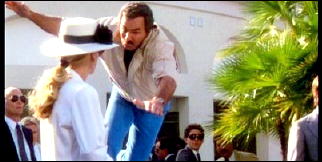
This is a slow tedious two hours with a story featuring more padding than mystery. Why bother with suspects when the story can focus on the reminisces and romance between the just yesterday widow and her childhood crush, Stryker?
How about a subplot with Stryker fixing up Oz with his ex-wife’s maid? You want action? Watch the Queen seduce Stryker with a cigar. Watch the two exchange long, long, long silent but meaningful looks. Detective work? How about a montage of Oz searching “the streets” for someone while Mike Post’s soundtrack screams in the background?
This episode introduces Stryker’s screwball secretary to run his office in a beachfront condemned building. Lyynda, with a photographic memory and too cute name, will take the job only if her dog stays with her.
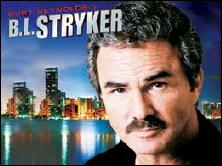
Stryker hates dogs. After that Stryker takes the dog with him everywhere, including when he and his comic relief neighbor, now millionaire computer genius, sneak into the police station to illegally use the Chief’s computer.
As for the ending, everyone involved should be in jail for theft.
This “Best Of” DVD is a major disappointment considering William Link (Colombo) and Joe Gores (Hammett) worked on this series, and Robert B. Parker (Spenser) and his wife Joan H. Parker wrote the Edgar nominated episode “Blues For Buder.”
The entire series is available on DVD, but suffering through these two episodes is enough for me.
Mon 5 Dec 2011
Posted by Steve under
Reviews[3] Comments
Reviewed by RICHARD & KAREN LA PORTE:
WILLIAM CAMPBELL GAULT – The Chicano War. Walker, hardcover, 1986. No paperback edition.
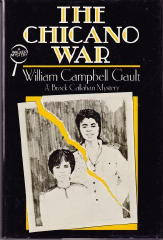
Brock Callahan, retired pro football star and private eye, takes in eleven year old Juan Chavez, who has run away from St. Mary’s foundling home. What Brock doesn’t guess is that he is also taking in a big piece of the gang/race war that is a hidden river of evil running under the peaceful streets of San Valdesto, a sun-warmed affluent “somewhat” north of Los Angeles.
Juan has a brother named Pete who is a skilled auto mechanic and who has disappeared. Chris Andropolus, the hoodlum who is trying to make San Valdes his private turf, opens a firebombing and shooting battle against the Brotherhood, who are a group of respectable Chicanos.
This battle culminates in the death of Andropolus and the arrest of Ricardo Cortez, a leader of the Brotherhood. The missing brother Pete is embroiled in an auto chopping operation run by one of Andropolus’s hired guns in the unincorporated and largely Chicano suburb north of San Valdesto.
Hatred grows and family ties are strained. The redneck Police Sergeant Karl Kranski’s niece is Mrs. Andropolus, and his wife is the former Lois Woolrick of local old and respectable money. By this time Callahan is playing touch-and-go with a three-sided war: the police, the gang, and the Chicanos. It’s an absolutely no-win affair.
Callahan is his usual bluff and charming self and welcome for various reasons in each of the three war camps. He is ably aided and abetted by a lovely friend Jan, an interior decorator, his housekeeper Mrs. Casey, and an old pro football buddy Orlando Davis, who is two hundred and seventy pounds of black wit.
The story abounds with ethnic names, ethnic slurs and vintage cars. As ever, Mr. Gault is a master of characterization by dialogue, revealing the undercurrents below the surface of a conversation. Like the eleven previous Brock Callahan books this is a highly readable caper featuring a really “laid back” all around good guy.
— Reprinted from The Poisoned Pen, Vol. 7, No. 1, Fall-Winter 1987.
Mon 5 Dec 2011
Posted by Steve under
Reviews[6] Comments
IT’S ABOUT CRIME, by Marvin Lachman
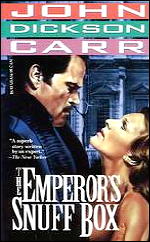
JOHN DICKSON CARR – The Emperor’s Snuff-Box (Carroll & Graf, paperback reprint, 1986. Harper & Brothers, hardcover, 1942. Many other editions, both hardcover & paperback. Film: That Woman Opposite (UK, 1957) aka City After Midnight (US).
This book is best described by quoting Carr, himself, regarding the murder in it: “This is a domestic crime. A cozy, comfortable, hearth-rug murder.”
Though not the author at his best, this is typical Carr. There is love at first sight, and the setting is France, though most of the characters are British. There is less atmosphere than usual, and the puzzle is a bit less complicated, and therefore more guessable than most Carr’s.
None of Carr’s usual series characters are present; the murder is investigated by a French policeman and a vacationing British psychiatrist. The time is the summer of 1939 and the delight of a simpler time and an intriguing puzzle make this worthwhile, even if it is not Carr at his peak.
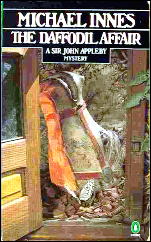
MICHAEL INNES – The Daffodil Affair. Penguin, paperback reprint, 1984. Several other paperback editions. Dodd Mead, hardcover, 1942.
— The Weight of the Evidence. Perennial Library, paperback reprint, 1983. Several other paperback editions. Dodd Mead, hardcover, 1943.
These books, original1y published in 1942 and 1943 respectively, come from the most imaginative period in the career of this writer who has been publishing mysteries for fifty years.
Daffodil is probably too wild and improbable for its own good, as we are asked to believe, on the basis of flimsy evidence, that Appleby and another Scotland Yard inspector would be sent out of war-time London into the jungles of South America.
The story begins attractively with the stolen titular horse and is heavy on human and animal psychology, accurately using the famous “Hans Legacy” about teaching horses tricks.
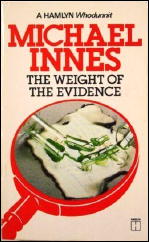
Finally, there is too little action and too unlikely an ending to justify what is otherwise an unusual and sophisticated book.
The Weight of the Evidence is relatively conventional for Innes, with its British university setting immediately before World War II, but it opens with an unpopular professor found crushed to death by a meteor.
It’s all very clever, but sometimes the literary allusions and sheer number of eccentric characters is a bit overdone. There’s a lot of good detection, though it is weakened by too much coincidence and a fortuitous confession at the end.
— Reprinted from The MYSTERY FANcier,
Vol. 8, No. 4, July-Aug 1986.
Sun 4 Dec 2011
EDWARD D. HOCH and HOLLYWOOD
by Mike Tooney
As prolific as Edward D. Hoch was — with over 900 short stories to his credit — the movie and TV media have made virtually no use of his output. The Internet Movie Database (IMDb) lists just 9 films derived from his works (9/900 = 1 percent). No more eloquent testimony against the obtuseness of Hollywood can be adduced.
1. “Off Season.” The Alfred Hitchcock Hour, May 10, 1965. With John Gavin, Richard Jaeckel, and Tom Drake. Based on Hoch’s story “Winter Run,” this is a nice little crime drama with a nasty twist. This show was the final one of the Hitchcock series.
2. It Takes All Kinds. Film, 1969, based on the story “A Girl Like Cathy.” With Robert Lansing, Vera Miles, and Barry Sullivan. Film critic Leonard Maltin describes it this way: “Fair double cross drama about Miles’ shielding of Lansing when he accidentally kills sailor in a brawl in Australia. Nothing special.”
3. “The Ring with the Red Velvet Ropes.” Rod Serling’s Night Gallery, November 5, 1972. With Gary Lockwood, Joan Van Ark, and Chuck Connors. I’m sure I saw this one but don’t remember a thing about it.
The TV series McMillan & Wife (1971-77) made good use of Hoch’s stories:
4. “Cop of the Year.” November 19, 1972. With Rock Hudson, Susan Saint James, John Schuck, Nancy Walker, and Edmond O’Brien. Based on “The Leopold Locked Room,” with John Schuck’s character doubling for Captain Leopold. Neat little impossible crime plot, with Schuck accused of murdering his ex-wife.
5. “Free Fall to Terror.” November 11, 1973. Guest stars: Edward Andrews, Tom Bosley, Barbara Feldon, John Fiedler, Dick Haymes, James Olson, and Barbara Rhoades. Based on one of Hoch’s best stories (“The Long Way Down”), a businessman evidently crashes through a plate glass window, disappears in mid-air, and hits the ground — three hours later.
6. “The Man without a Face.” January 6, 1974. Guest stars: Dana Wynter, Nehemiah Persoff, Stephen McNally, Donna Douglas, and Steve Forrest. Cold War espionage with a mystery slant.
The French produced a mini-series in the mid-’70s:
7. Nick Verlaine ou Comment voler la Tour Eiffel. Five episodes, France, July-August 1976. If anybody knows anything about this production, please inform us.
The British horror/fantasy series Tales of the Unexpected used a couple of Hoch’s stories as inspiration:
8. “The Man at the Top.” June 14, 1980. Introducer: Roald Dahl. With Peter Firth, Rachel Davies, and Dallas Cavell.
9. “The Vorpal Blade.” May 28, 1983. With Peter Cushing, Anthony Higgins, John Bailey, and Andrew Bicknell.
— and, unless the IMDb list is woefully incomplete, that’s the extent of the film industry’s use of Edward D. Hoch’s stories.
Sun 4 Dec 2011
Hi Steve,
Some friends and I just got wind of this virtually unknown CBS-TV series a couple of months ago accidentally, via an odd old Google News result from Billboard magazine about notable composer Alex North’s jazz theme.
There’s no mention of the 1959 series in John McAleer’s humongous Stout biography, although a pilot plus a few episodes were actually filmed and it came within an eyelash of being Nero Wolfe’s TV debut — contradicts the conventional wisdom that Stout had vetoed any further screen adaptations during his lifetime due to his disappointment with the 1930s movies.
Here it is, complete with the lone screenshot evidence we found — Shatner’s Archie with Kurt Kasnar’s Wolfe — on Wikipedia’s entries for Nero Wolfe and Shatner:
http://en.wikipedia.org/wiki/Nero_Wolfe#Nero_Wolfe_.28CBS.29
http://en.wikipedia.org/wiki/William_Shatner#Early_stage.2C_film.2C_and_television_work
Alerting you because I remember Mystery*File and its followers expressing interest in early “NW” adaptations that were or might have been, and this one’s quite a revelation.
Sat 3 Dec 2011
Posted by Steve under
ReviewsNo Comments
REVIEWED BY WALTER ALBERT:
IAN RANKIN – Dead Souls. St. Martin’s Minotaur, hardcover, 1999; paperback, August 2000. Reprinted several times since.
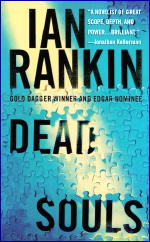
Rebus is not in good shape in this above-average entry in the Edinburgh series. He’s drinking again, his daughter is still recovering from a hit and run accident and is in a wheelchair. His friend Joe Morton has died, and the entire unit is reeling from the apparent suicide of DI Jim Margolies, bright and talented, on the fast track toward the top.
The plot includes two missing persons, an eight-year-old boy and the 19-year-old son of childhood friends of Rebus; a surveillance of a convicted murderer, released from a US prison in the wake of an appeal of trial irregularities and returned to Edinburgh; and the relocation of a recently released pedophile that leads to Rebus’s being suspected of conducting a personal crusade against him.
The convicted murderer has matured from an impulsive, opportunistic criminal to a calculating, clever game-player who threatens not only Rebus but everyone he cares about. Even as you tell yourself that the conjunction of difficult, challenging problems is the stuff of improbable fictions, you find yourself admiring Rankin’s ability to manage intricately connected plot lines.
A superior, disturbing police procedural and thriller.
NOTE: St. Martin’s has also published a section of the novel in hardcover as an $11.95 “novella” entitled Death Is Not The End. If I had read the front jacket flap material more closely, I wouldn’t have gotten suckered into buying this.
Sat 3 Dec 2011
Posted by Steve under
ReviewsNo Comments
IT IS PURELY MY OPINION
Reviews by L. J. Roberts
DENNIS LEHANE – Moonlight Mile. William Morrow, hardcover, November 2010. Harper, premium-sized paperback, July 2011.
Genre: Private Investigator. Leading characters: Patrick Kenzie & Angie Gennaro; 6th in series. Setting: Massachusetts.
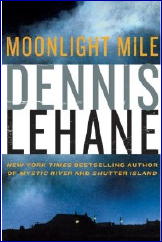
First Sentence: On a bright, unseasonably warm afternoon in early December, Brandon Trescott walked out of the spa at the Chatham Bars Inn on Cape Cod and got into a taxi.
Eleven years ago, as told in Gone, Baby, Gone (1999), Patrick Kenzie and Angie Gennaro found kidnapped Amanda McCredy and, following the law, returned her to her neglectful mother.
Now, at 16, Amanda has disappeared again and her aunt re-hires Kenzie and Gennaro to find her. A missing-person case quickly escalates to one involving identity theft, drugs, a priceless cross, Russian gangsters and a threat on Patrick’s family.
It is very nice to have back the characters that brought Lehane to forefront of mystery writing. It is also nice that their lives have evolved and that they are parents of a quite realistic, four-year old daughter.
I also enjoyed having back Bubba, one of the best psychotic sidekicks ever, but his role felt a bit as though it was playing homage to Robert B. Parker’s characters of Hawk to Susan; protector but not participant. While Amanda had dimension and strength, others seemed flat and bordering on stereotypical.
Lehane has a great voice which carries over to a natural ear for dialogue and his evocative descriptions set the mood and sense of place… “The trees were bare […], and cold air off the ocean hunted the gaps in my clothes.â€
The plot was page-turning with some very well-done, unexpected twists, the climax felt over the top, and I did like the ending. Lehane again addresses the struggle between doing what is legally correct versus morally correct and who has the right to make that decision.
Reading this book was interesting. When I read A Drink Before the War, the first book in the series, it was coup de foudre; that lightning strike you may experience when meeting someone wonderful for the first time. Eleven years on, the lightning bolt is gone, but there is still enough of a tingle to say I did enjoy the book.
Rating: Good.
Sat 3 Dec 2011
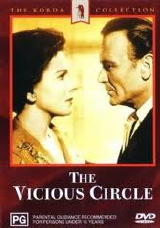
THE VICIOUS CIRCLE. Romulus Films, 1957. Also released as The Circle. John Mills, Derek Farr, Noelle Middleton, Wilfrid Hyde White, Roland Culver, Mervyn Johns, Rene Ray, Lionel Jeffries. Screenplay: Francis Durbridge, based on his BBC-TV serial, My Friend Charles. [See comment #1.] Director: Gerald Thomas.
This is one of those movies in which the hero, in this case Dr. Howard Latimer (John Miles), finds himself trapped in a series of strange events that culminate in his being the number one suspect in a case of murder. This time around, the dead girl is an actress from Germany that a producer friend (just in from the US) asks him to pick up at the airport.
Accompanying him to the airport is a newspaper reporter who (as it turns out) the paper never heard of, nor is the producer even in the country. The dead girl is in Latimer’s apartment when he returns later.
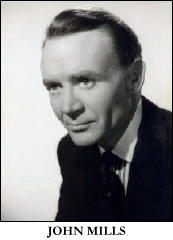
How and why? He has no idea. Not helping either is the patient who’s been referred to him by another doctor (who has never seen her), but who complains not only of migraines but also of dreams involving a body and a brass candlestick.
Two guesses what the blunt instrument was that caused the death of the woman in his apartment? Or in whose car it is found?
This is also one of those movies that is too complicated for its own good. There is an attempt to explain all this, and it’s a pretty good attempt too, until the movie’s over and you wonder what on earth were you thinking?
One large problem is that it is clear that the detective from Scotland Yard, Detective Inspector Dane (Roland Culver), does not take the case against Dr. Latimer all that seriously, alleviating most of the suspense. Either Cornell Woolrich (author) or Alfred Hitchcock (director) or the combination thereof, could have taken the first 20 minutes and run for a mile with it.
Since neither of the two were on hand, all we have is a mildly amusing puzzle to undo, nothing more, but nothing less, either. All the players are professionals, even if relatively unknown in this country, then or now.
« Previous Page — Next Page »
















